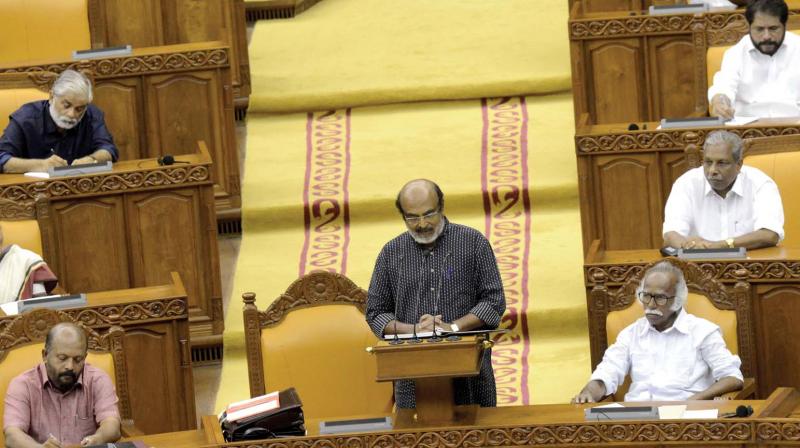Kerala budget 2017: Reengineering on taxation front
The administrative mindset of the tax agency has to undergo a paradigm shift.

The budget Finance Minister Thomas Isaac is going to present in the Assembly will have a few firsts. a) This budget will have to oversee the phasing out of Value Added Tax levied on purchases and sales within the State and Central Sales Tax levied on commodities produced in the State, but sold across State borders b) Check posts are going to become history, even though government can retain some surveillance mechanisms and c) the administrative mindset of the tax agency has to undergo a paradigm shift. At the policy level, the tax base of the State is going to expand by the inclusion of services sector. Yet another important source of expansion is that taxes on all items consumed in the State would come to its kitty.
Tax on purchases of items for personal use, made anywhere in India by a resident of Kerala, would become Kerala's tax revenue, unlike the present scene in which the tax is paid in the producing or selling State and the consumer State gets nothing. (Under GST, even if a Kerala resident purchases goods in Tamil Nadu, the tax will be received in the state of residence of the buyer, in the address noted in the GST sales form.) Being the topmost consumer State in the country, as per the five-yearly survey of National Sample Survey Organization 2012, Kerala could gain substantially on this count.
Here, one has to take note of the flip side. GST is a tax in which tax paid on inputs is given credit when output is taxed. Kerala will also have the obligation of giving more input tax credits both for goods and services. Still, the expectation is that gains would outweigh the losses. However, the metamorphosis of VAT into GST comes with a political cost. Hitherto, the State Finance Ministers had discretion to alter rates of taxes, even though the Empowered Committee of State finance ministers prescribed indicative rates. In contrast, GST Council as a Constitutional body fixes rates that the State cannot alter.
State Finance Ministers, being members of GST council can put forth the demands there. The Centre too is hamstrung, but has much more wide taxation powers in direct taxes and customs duties, which are outside GST. Hence, it may not be prudent to expect any change in tax rates of goods in the budget, as we would have to move to GST probably by July. Tax department and its administrative efficiency could be the focus, as rate variation goes outside its province and also that of future budgets. Commodities on which State budgets can vary rates are petroleum products (for some time till they come under GST) and alcoholic liquor for human consumption. This leaves other taxes like motor vehicles, stamp duty and land tax as variables.
One cannot be faulted, if she believes that this budget will herald the beginning of almost total thrust on expenditure side. This would be welcome, if efficiency of expenditure can be targeted As VAT faces sunset, there could be an accelerated effort to clean up disputed demands so that tax re-engineering starts on a clean slate. GST, it is hoped, would be more technology-based and will straighten up chronic disputes. Last but not the least, the implementation of GST may stoke some inflationary pressures, which may strain the expenditure budget of the State, as more outgo of subsidies for essential commodities may have to be provided.
Kerala has stood in front for demanding best practices while conceiving GST framework. It can be legitimately expected that in practice also, this would continue. This budget is the first one after a pragmatic yet compelled compromise in favour of a regressive tax, which obviously can bring incremental revenues to the State, utilising which welfare measures can continue even in the face of fiscal orthodoxy, epitomised by Fiscal Responsibility and Budget Management Act (FRBMA).
Total revenues up, but tax income down: CAG
What should be seen as a major achievement, the considerable reduction in revenue and fiscal deficits during 2015-16, in truth was just a stroke of luck. Revenue receipts had increased, and thus deficits reduced, mainly because of the 14th Finance Commission's generous deficit grants passed on to the state. But the devil is in the fine print of the Comptroller and Auditor General Report on State Finances for 2015-16, which was presented in the Assembly on Tuesday. Revenue receipts have increased, but what is significant is that both the share of state's own receipts (tax and non-tax) and own tax receipts in the total revenue have shown a decreasing trend. It also helped that the largest chunk of the three-phase grant (Rs 4,640 crore) was received in 2015-16.
Meaning, it will not exist to prop up deficits from 2018-19. Even in 2017-18, the last year of the deficit grant, it will be less than Rs 1,000 crore. So if revenue deficits have to be consistently reduced, state's own tax revenues have to improve. And this is not happening according to the CAG report. The total revenue receipts of the state (which is a combination of tax and non-tax revenue and share of union taxes and grants-in-aid from the Centre) increased from Rs 38,010 crore in 2011-12 to Rs 69,033 crore in 2015-16, recording a growth of 82 percent.
But the CAG report points out that the state's own receipts (tax and non-tax), which is the major component of revenue receipts, has shown a steady decline in its share in revenue receipts during the last four years from 78 per cent in 2012-13 to 69 percent in 2015-16. What's more, the share of own tax receipt in the total revenue receipt also showed a decreasing trend during the last five years, decreasing from 68 percent in 2011-12 to 57 percent in 2015-16. Further, the share of state's own tax revenue in GSDP has been dwindling during the UDF tenure. From 8.23 percent in 2011-12 it has consistently fallen and has dropped to 6.66 percent in 2015-16. The rate of growth of tax revenue has also been stagnant; from a growth of 10.12 percent during 2014-15 it rose just marginally to 10.68 in 2015-16.

